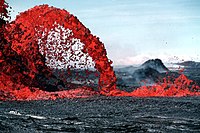
Photo from wikipedia
Abstract Mount Erebus on Ross Island, Antarctica is an active volcano that has hosted a persistent phonolite lava lake for over 50 years. Oxygen isotope analysis of minerals in alkaline… Click to show full abstract
Abstract Mount Erebus on Ross Island, Antarctica is an active volcano that has hosted a persistent phonolite lava lake for over 50 years. Oxygen isotope analysis of minerals in alkaline basanite to phonolite lavas from Erebus and surrounding volcanic centers show an anomalous trend of decreasing δ18O with magmatic evolution. The cold frozen climate and lack of radiogenic isotope evidence for assimilation of crustal materials makes this a unique location to investigate factors contributing to changes in oxygen isotope compositions. Olivine, feldspar, glass and whole rock samples from 29 lavas, 7 modern bombs and 2 xenoliths were analyzed for their oxygen isotopic compositions. Forward models indicate there should be an enrichment in δ18O of 0.4‰ in lavas due to Raleigh fractionation, but this is not observed. Olivine δ18O decreases from a typical mantle value of +5.3‰ in the parental basanite source to 4.3‰ in recently erupted phonolite lava bombs. The trend correlates with a decreasing forsterite content in the olivine. Feldspar and glasses exhibit δ18O values well below predicted values and are in fractionation disequilibrium with olivine compositions at measured magmatic temperatures of 1000°C within the phonolite lava lake. Isotopic depletion of the melt may be accounted for by incorporation of 8-11% hydrothermally altered volcanic edifice over time assuming water–rock interaction from strongly isotopically depleted Antarctic precipitation. Enhanced disequilibrium with olivine phenocrysts, are seen during the late stages of Erebus volcano construction. This calls for differential fractionation of olivine and feldspar from their respective melts, and slow O-diffusion of olivine while in the shallow lava lake prior to eruption.
Journal Title: Geochimica et Cosmochimica Acta
Year Published: 2021
Link to full text (if available)
Share on Social Media: Sign Up to like & get
recommendations!